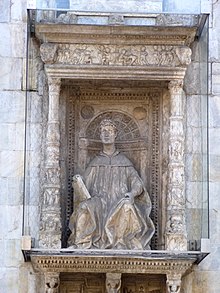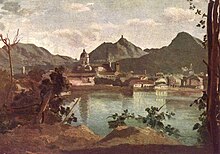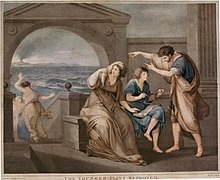Pliny the Younger
| |
|---|---|
Gaius Plinius Caecilius Secundus
| |

Statue of Pliny the Younger on the facade of Cathedral of S. Maria Maggiore in Como
| |
| Born |
Gaius Caecilius Cilo
61 AD |
| Died | c. 113 AD (aged approx. 52) |
| Occupation | Politician, judge, author |
| Parent(s) | Lucius Caecilius Cilo and Plinia Marcella |
Gaius Plinius Caecilius Secundus, born Gaius Caecilius or Gaius Caecilius Cilo (61 – c. 113), better known as Pliny the Younger (/ˈplɪni/), was a lawyer, author, and magistrate of Ancient Rome. Pliny's uncle, Pliny the Elder, helped raise and educate him.
Pliny the Younger wrote hundreds of letters, of which 247 survive and are of great historical value. Some are addressed to reigning emperors or to notables such as the historian Tacitus. Pliny served as an imperial magistrate under Trajan (reigned 98–117), and his letters to Trajan provide one of the few surviving records of the relationship between the imperial office and provincial governors.
Pliny rose through a series of civil and military offices, the cursus honorum. He was a friend of the historian Tacitus and might have employed the biographer Suetonius on his staff. Pliny also came into contact with other well-known men of the period, including the philosophers Artemidorus and Euphrates the Stoic, during his time in Syria.
Background
Childhood
Como and Lake Como in 1834, painted by Jean-Baptiste-Camille Corot
Pliny the Younger was born in Novum Comum (Como, Northern Italy) around 61 AD, the son of Lucius Caecilius Cilo, born there, and his wife Plinia Marcella, a sister of Pliny the Elder. He was the grandson of Senator and landowner Gaius Caecilius, revered his uncle, Pliny the Elder (who at this time was extremely famous around the Roman Empire), and provided sketches of how his uncle worked on the Naturalis Historia.
Cilo died at an early age, when Pliny was still young. As a
result, the boy probably lived with his mother. His guardian and
preceptor in charge of his education was Lucius Verginius Rufus, famed for quelling a revolt against Nero in 68 AD.
After being first tutored at home, Pliny went to Rome for further education. There he was taught rhetoric by Quintilian,
a great teacher and author, and Nicetes Sacerdos of Smyrna. It was at
this time that Pliny became closer to his uncle Pliny the Elder. When
Pliny the Younger was 17 or 18, his uncle Pliny the Elder died
attempting to rescue victims of the Vesuvius eruption, and the terms of the Elder Pliny's will passed his estate to his nephew. In the same document the younger Pliny was adopted by his uncle. As a result, Pliny the Younger changed his name from Gaius Caecilius Cilo to Gaius Plinius Caecilius Secundus (his official title was Gaius Plinius Luci filius Caecilius Secundus).
The Younger Pliny Reproved, colorized copperplate print by Thomas Burke (1749–1815)
There is some evidence that Pliny had a sibling. A memorial erected in Como (now CIL V, 5279) repeats the terms of a will by which the aedile
Lucius Caecilius Cilo, son of Lucius, established a fund, the interest
of which was to buy oil (used for soap) for the baths of the people of
Como. The trustees are apparently named in the inscription: "L.
Caecilius Valens and P. Caecilius Secundus, sons of Lucius, and the contubernalis Lutulla." The word contubernalis
describing Lutulla is the military term meaning "tent-mate", which can
only mean that she was living with Lucius, not as his wife. The first
man mentioned, L. Caecilius Valens, is probably the older son. Pliny the
Younger confirms
that he was a trustee for the largesse "of my ancestors". It seems
unknown to Pliny the Elder, so Valens' mother was probably not his
sister Plinia; perhaps Valens was Lutulla's son from an earlier
relationship.
Marriages
Pliny
the Younger married three times, firstly, when he was very young (about
18), to a stepdaughter of Veccius Proculus', who died at age 37;
secondly, at an unknown date, to the daughter of Pompeia Celerina; and thirdly to Calpurnia, daughter of Calpurnius and granddaughter of Calpurnius Fabatus of Comum.
Letters survive in which Pliny recorded this last marriage taking
place, his attachment to Calpurnia, and his sadness when she miscarried
their child.
Death
Pliny is thought to have died suddenly during his convention in Bithynia-Pontus, around 113 AD, since no events referred to in his letters date later than that.
Career
Pliny was by birth of equestrian rank, that is, a member of the aristocratic order of equites (knights), the lower (beneath the senatorial order)
of the two Roman aristocratic orders that monopolised senior civil and
military offices during the early Empire. His career began at the age of
18 and initially followed a normal equestrian route. But, unlike most
equestrians, he achieved entry into the upper order by being elected Quaestor in his late twenties.
Pliny was active in the Roman legal system, especially in the sphere of the Roman centumviral court,
which dealt with inheritance cases. Later, he was a well-known
prosecutor and defender at the trials of a series of provincial
governors, including Baebius Massa, governor of Baetica; Marius Priscus, governor of Africa; Gaius Caecilius Classicus, governor of Baetica; and most ironically in light of his later appointment to this province, Gaius Julius Bassus and Varenus Rufus, both governors of Bithynia and Pontus.
Pliny's career is commonly considered as a summary of the main
Roman public charges and is the best-documented example from this
period, offering proof for many aspects of imperial culture.
Effectively, Pliny crossed all the principal fields of the organization
of the early Roman Empire. It is an achievement for a man to have not
only survived the reigns of several disparate emperors, especially the
much-detested Domitian, but also to have risen in rank throughout.
Career summary
| c. 81 | One of the presiding judges in the centumviral court (decemvir litibus iudicandis) |
| c. 81 | Tribunus militum (staff officer) of Legio III Gallica in Syria, probably for six months |
| 80s | Officer of the noble order of knights (sevir equitum Romanorum) |
| Later 80s | Entered the Senate |
| 88 or 89 | Quaestor attached to the Emperor's staff (quaestor imperatoris) |
| 91 | Tribune of the People (tribunus plebis) |
| 93 | Praetor |
| 94–96 | Prefect of the military treasury (praefectus aerarii militaris) |
| 98–100 | Prefect of the treasury of Saturn (praefectus aerari Saturni) |
| 100 | Suffect consul with Cornutus Tertullus |
| 103–104 | Publicly elected Augur |
| 104–106 | Superintendent for the banks of the Tiber (curator alvei Tiberis) |
| 104–107 | Three times a member of Trajan's judicial council. |
| 110 | The imperial governor (legatus Augusti) of Bithynia et Pontus province |
Writings
Pliny penned his first work at age 14: a tragedy in Greek. Additionally, in the course of his life, he wrote numerous poems, most of which are lost. He was also known as a notable orator; though he professed himself a follower of Cicero's, Pliny's prose was more magniloquent and less direct than Cicero's.
Pliny's only oration that now survives is the Panegyricus Traiani. This was delivered in the Senate in 100 and is a description of Trajan's figure and actions in an adulatory and emphatic form, especially contrasting him with the Emperor Domitian.
It is, however, a relevant document that reveals many details about the
Emperor's actions in several fields of his administrative power such as
taxes, justice, military discipline, and commerce. Recalling the speech
in one of his letters, Pliny shrewdly defines his own motives thus:
I hoped in the first place to encourage our Emperor in his virtues by a sincere tribute and, secondly, to show his successors what path to follow to win the same renown, not by offering instruction but by setting his example before them. To proffer advice on an Emperor's duties might be a noble enterprise, but it would be a heavy responsibility verging on insolence, whereas to praise an excellent ruler (optimum principem) and thereby shine a beacon on the path posterity should follow would be equally effective without appearing presumptuous.
Epistulae
The largest surviving body of Pliny's work is his Epistulae (Letters), a series of personal missives directed to his friends and associates. These letters are a unique testimony of Roman
administrative history and everyday life in the 1st century AD.
Especially noteworthy among the letters are two in which he describes
the eruption of Mount Vesuvius in October 79, during which his uncle Pliny the Elder died (Epistulae VI.16, VI.20), and one in which he asks the Emperor for instructions regarding official policy concerning Christians (Epistulae X.96).
Epistles concerning the eruption of Mount Vesuvius
Pliny
wrote the two letters describing the eruption of Mount Vesuvius
approximately 25 years after the event, and both were sent in response
to the request of his friend, the historian Tacitus,
who wanted to know more about Pliny the Elder's death. The two letters
have great historical value due to their accurate description of
Vesuvius' eruption; Pliny's attention to detail in the letters about
Vesuvius is so keen that modern volcanologists describe those types of eruptions as "Plinian eruptions".
Epistle concerning the Christian religion
As the Roman governor of Bithynia-Pontus (now in modern Turkey) Pliny wrote a letter to Emperor Trajan around 112 AD and asked for counsel on dealing with Christians. In the letter (Epistulae
X.96) Pliny detailed an account of how he conducted trials of suspected
Christians who appeared before him as a result of anonymous accusations
and asked for the Emperor's guidance on how they should be treated.
Pliny had never performed a legal investigation of Christians and thus
consulted Trajan in order to be on solid ground regarding his actions.
Pliny saved his letters and Trajan's replies and these are the earliest surviving Roman documents to refer to early Christians.
Manuscripts
The first – incomplete – edition of Pliny's Epistles was published in Italy in 1471. Sometime between 1495 and 1500 Giovanni Giocondo
discovered a manuscript in Paris of Pliny's tenth book of letters,
containing his correspondence with Trajan, and published it in Paris,
dedicating the work to Louis XII. The first complete edition was produced by the press of Aldus Manutius in 1508.
Villas, farms and estates
View of Bellagio in Lake Como. The institution on the hill is Villa Serbelloni, believed to have been constructed on the site of Pliny's villa "Tragedy."
Pliny loved villas. Being wealthy, he owned many, and wrote in detail about his villa near Ostia, at Laurentium. Others were the one in Lake Como named "Tragedy" because of its location high on a hill, and, on the shore of the lake, "Comedy," so called because it was sited low down. Pliny's main estate in Italy was in the north of Umbria, by Tifernum Tiberinum, under the passes of Bocca Trabaria and Bocca Serriola, where wood was harvested for Roman ships and sent to Rome via the Tiber.
According to G. E. M. de Ste. Croix,
as a response to "declining returns from his north Italian farms",
Pliny begins to contemplate switching the administration of his estate
to a sharecropping system called colonia partiaria.
Under the sharecropping system Pliny's slaves would act as overseers.
Ste. Croix speculated this may have been an intermediary period before serfdom fully replaces slavery in later centuries.




